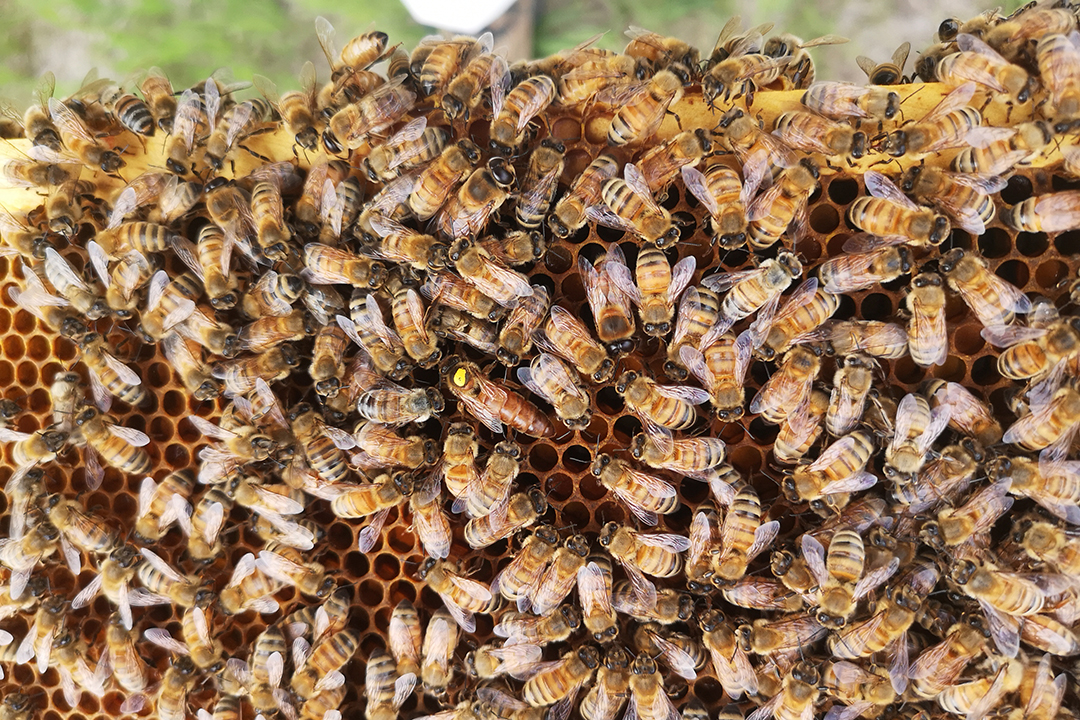
Study focuses on bee world’s royalty
Western College of Veterinary Medicine (WCVM) researchers have welcomed female royalty onto campus. But their brush with the upper crust is in a much different class than Meghan Markle or Kate Middleton.
By Sarah BarnsleyIn this case, royalty refers to a honey bee queen — an essential component of any honey bee hive.
“Queens are fascinating,” says Dr. Ivanna Kozii, a PhD candidate in the WCVM’s Department of Veterinary Pathology. “The queen is the ‘master puppeteer,’ the only individual in the colony who can create offspring, and she lays up to 2,000 eggs per day. She emits pheromones which control the behaviour of the entire population within the hive.”
Despite the importance of the honey bee queen, past research has focused more on worker bees with surprisingly little attention paid to the queen’s health and reproduction.
Kozii and a team of scientists at the WCVM’s honey bee research lab are now addressing that research gap as they investigate the effects of neonicotinoid pesticides on the queen’s reproductive health and its ability to produce offspring.
“If a queen becomes ill or is exposed to certain toxins, she will underperform and the workers will decide to replace her,” says Kozii, whose graduate supervisor is WCVM veterinary pathologist Dr. Elemir Simko. He established the honey bee-focused research lab in 2015.
A typical bee hive consists of three different types or castes of bees: workers, drones and queens. The workers are the caste of honey bee that everyone is probably most familiar with — they’re the ones seen buzzing around a hive and foraging for pollen in fields and backyards. The drones are the male bees, and their main role is to provide mating opportunities for the queen.
It’s not unusual to see Kozii and her team methodically looking through their honey bee colonies, frame by frame, as they search for the elusive and mysterious queen honey bee. It’s like nature’s version of the “I Spy” game since the queen can be hidden among 80,000 bees.
Once the researchers locate the queen, they evaluate her reproductive tissues microscopically. Since the queens have been exposed to sub-lethal doses of neonicotinoids, this microscopic evaluation will provide important data for regulatory framework about the use of neonicotinoids.
“The minute neonicotinoid doses found in honey bee products pose no concern to human health; however, the effects of bees’ chronic exposure to these chemicals in the hive is not yet clearly defined” Kozii explains.
“However, [neonicotinoid] exposure to honey bees over time may trigger other effects that are not easily detectable by current regulatory tests.”
Neonicotinoids, a commonly used class of pesticides in Saskatchewan, have been a primary focus for the scientists in Simko’s honey bee lab. They have conducted a number of investigations into the pesticide’s effects on honey bee health and survival.
Neonicotinoids have been implicated in the phenomenon known as colony collapse, an occurrence in which most of the worker bees disappear from a hive. Although the hive still contains plenty of food, the queen and the remaining immature bees are left with only a few nurse bees to care for them.
Kozii points out that there are several factors contributing to the decline in honey bee populations — a complex issue that can’t be blamed on pesticides alone.
She emphasizes the importance of honey bees to the human population and cautions that as the need for global food production increases substantially in the coming years, humans must not forget about the vital role of pollinators such as honey bees.
“The services that bees provide go far beyond pollination,” says Kozii. “We all enjoy the products that the honey bees give us like honey, propolis, pollen, beeswax and royal jelly — [products] that are used not only in the food industry but also [in] other industries such as cosmetics.”
Although Kozii has a soft spot for the queen, she stresses that all of the castes in a hive are important.
“You can’t really say that one caste is more important than another, because the castes rely on each other to survive — that’s what makes them a superorgansim.”
Sarah Barnsley of Saskatoon, Sask., is a second-year veterinary student student at the Western College of Veterinary Medicine (WCVM). Her story is part of a series of articles written by WCVM summer research students.
